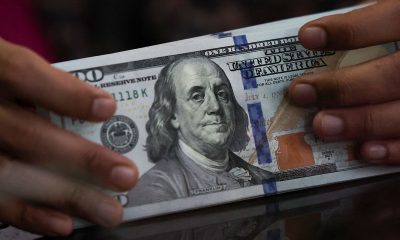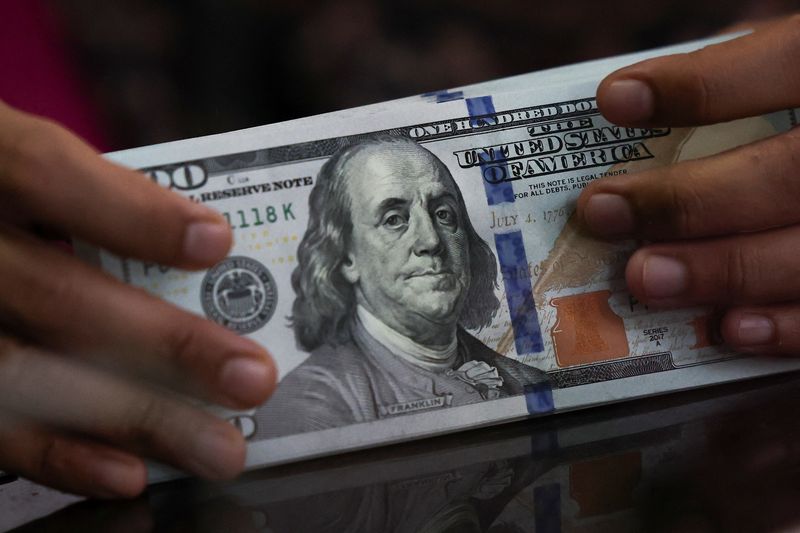Forex
Dollar drifts lower ahead of PCE data; Eurozone inflation expectations lowered
Investing.com – The U.S. dollar drifted lower Friday, ahead of the release of key U.S. inflation data, which could drive sentiment with the Federal Reserve meeting next week.
At 04:55 ET (08:55 GMT), the Dollar Index, which tracks the greenback against a basket of six other currencies, traded 0.1% lower at 105.395, having climbed to 106.00 on Thursday.
Dollar awaits PCE data
Data released on Thursday showed that U.S. grew at a 1.6% annualized rate in the January-March period, much slower than the 2.4% rate expected.
That said, the report also showed that underlying inflation as measured by the core personal consumption expenditures price index rose 3.7% in the first quarter, beating forecasts for a 3.4% rise.
Fed officials have made it pretty clear over the last few weeks that they remained concerned about inflation, prompting the market to rein in expectations of an early interest rate cut.
Attention now turns to the release later in the session of the data for March, widely seen as the Fed’s most important gauge of inflation.
“The main drivers of FX all point to a stronger dollar: higher Treasury yields, widening swap differentials in favour of the dollar, and falling equities,” said analysts at ING, in a note.
“There is a good chance that markets will scale back US rate cuts further if core PCE comes in at 0.4% month-on-month today.”
Eurozone consumer rein in inflation expectations
In Europe, rose 0.2% to 1.0746, benefiting from the dollar’s weaker tone.
remove ads
.
Eurozone consumers saw inflation in the next 12 months at 3.0%, just below the 3.1% expected a month earlier, according to the ECB’s Consumer Expectations Survey.
This was the lowest reading since December 2021.
However, inflation expectations for three years ahead held steady for a fourth consecutive month at 2.5%, above the European Central Bank’s 2.0% target.
The ECB is planning to cut interest rates in June but the outlook further out remains clouded by rising energy costs, stubbornly high services inflation and continued geopolitical tensions.
rose 0.2% to 1.2532, benefiting from the recent dollar weakness.
“The BoE policy meeting on 9 May is obviously the next big event for the pound, but data may still prove more important given a divided MPC,” said ING.
USD/JPY hits new 34-year high
In Asia, rose 0.6% to 156.58, rising past the 156 level to new 34-year highs after the left interest rates unchanged after a historic hike in March.
The central bank also forecast higher inflation in the coming years, but also forecast weaker economic growth, raising doubts over just how much capacity it would have to keep raising interest rates.
Softer-than-expected inflation data from Tokyo, released earlier on Friday, further sparked doubts over a hawkish BOJ.
edged 0.1% higher to 7.2466, remaining close to five-month highs.
rose 0.5% to 0.6552, supported by strong Australian inflation data, which, coupled with higher CPI reading earlier this week, sparked bets on higher-for-longer rates in the country.
remove ads
.

 Forex3 years ago
Forex3 years agoForex Today: the dollar is gaining strength amid gloomy sentiment at the start of the Fed’s week

 Forex3 years ago
Forex3 years agoUnbiased review of Pocket Option broker

 Forex3 years ago
Forex3 years agoDollar to pound sterling exchange rate today: Pound plummeted to its lowest since 1985

 Forex3 years ago
Forex3 years agoHow is the Australian dollar doing today?

 Cryptocurrency3 years ago
Cryptocurrency3 years agoWhat happened in the crypto market – current events today

 World3 years ago
World3 years agoWhy are modern video games an art form?

 Commodities3 years ago
Commodities3 years agoCopper continues to fall in price on expectations of lower demand in China

 Economy3 years ago
Economy3 years agoCrude oil tankers double in price due to EU anti-Russian sanctions





























